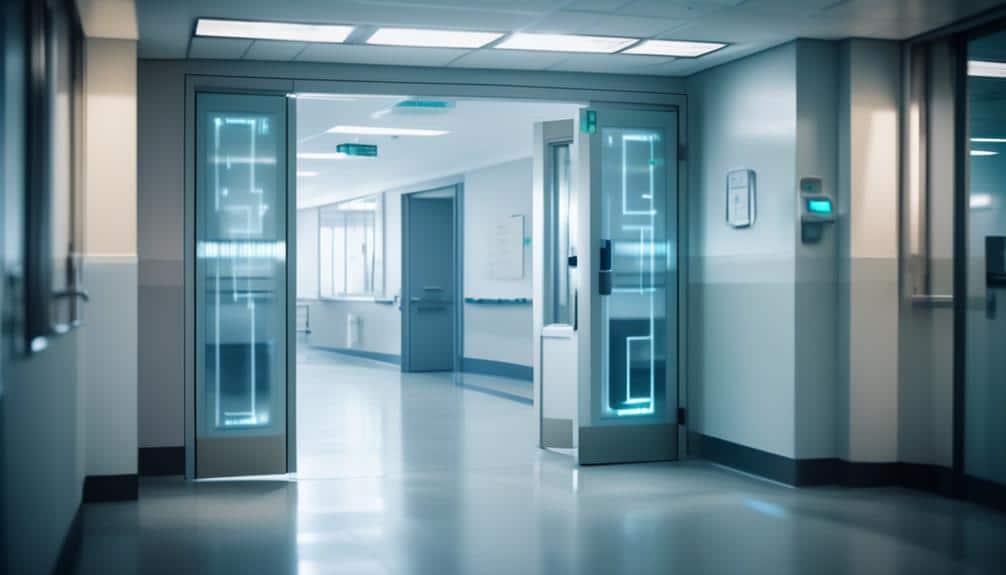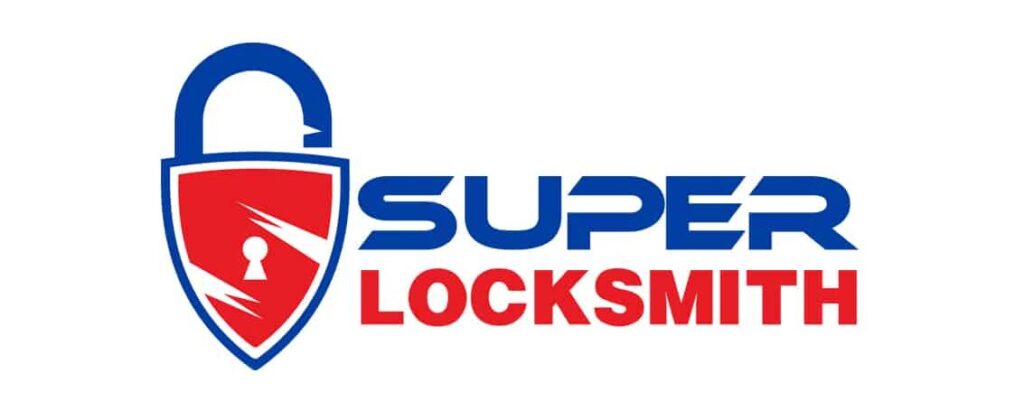What makes a healthcare facility truly secure? Is it the state-of-the-art technology or the advanced systems in place?
When it comes to protecting sensitive information and ensuring the safety of patients and staff, choosing the best high-security locks becomes paramount. In this discussion, we will explore the options available, from electronic locks and biometric systems to keycard access and smart locks, to determine the most effective solutions for healthcare facilities.
Join us as we unravel the keys to a secure environment where peace of mind is the ultimate goal.
Electronic Locks
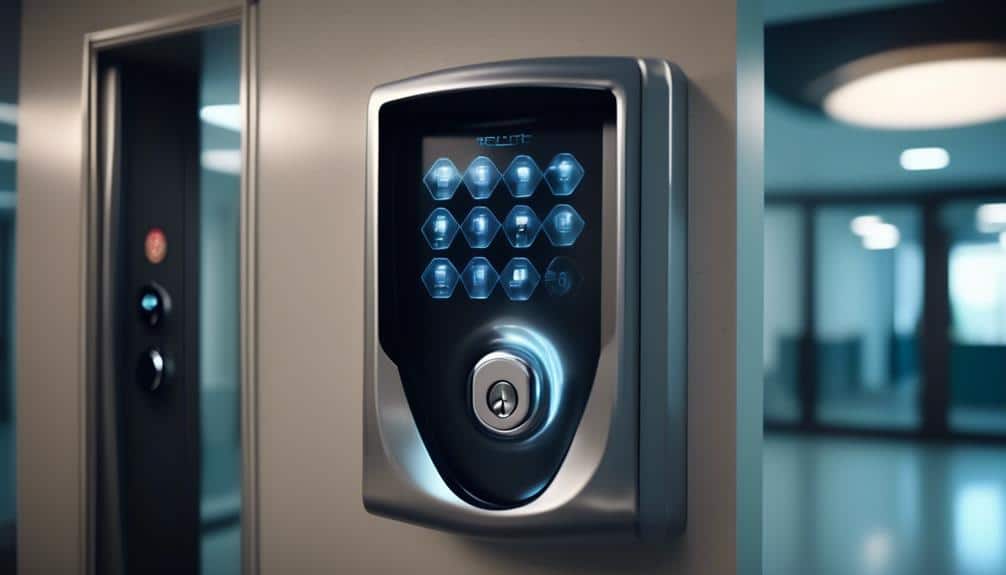
We highly recommend implementing electronic locks for enhanced security in healthcare facilities. Electronic locks provide a reliable and efficient solution for controlling access to sensitive areas within healthcare facilities. With the advancement of wireless technology, electronic locks can now offer keyless entry, making them even more convenient and secure.
One of the key advantages of electronic locks is their ability to provide real-time access control. By using wireless technology, these locks can be connected to a central system, allowing administrators to monitor and control access remotely. This not only enhances security but also improves operational efficiency by eliminating the need for physical keys and manual lock changes.
Furthermore, electronic locks with keyless entry offer an added layer of security. Instead of traditional keys that can be lost or stolen, keyless entry systems use credentials such as key cards or biometric data for access. This eliminates the risk of unauthorized duplication or use of keys, ensuring that only authorized personnel can enter restricted areas.
In addition to security benefits, electronic locks also provide a seamless user experience. With keyless entry, healthcare staff can easily access designated areas without the hassle of carrying and managing physical keys. This not only saves time but also reduces the risk of misplaced or lost keys.
Biometric Locks
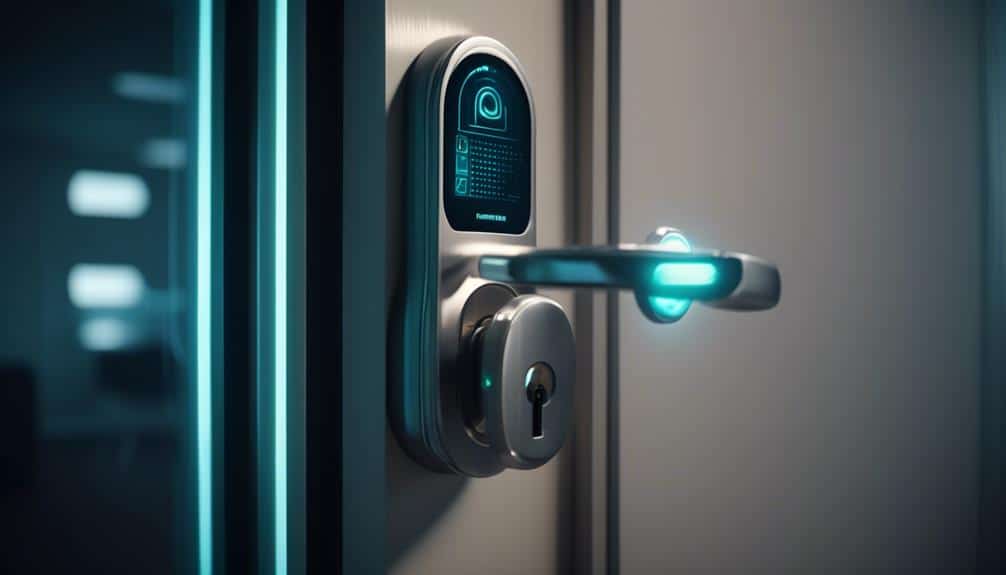
Biometric locks offer advanced access control and enhanced security measures for healthcare facilities. These locks utilize unique physical or behavioral characteristics, such as fingerprints or iris patterns, to grant or deny access.
Biometric lock applications can range from securing medication cabinets to restricting access to sensitive areas like laboratories or operating rooms.
Advanced Access Control
Implementing advanced access control systems, such as biometric locks, enhances the security of healthcare facilities by utilizing unique physiological or behavioral characteristics for authorized entry. These advanced systems offer an additional layer of protection, ensuring that only authorized personnel can access sensitive areas within the facility. Biometric locks use various biometric traits, such as fingerprints, iris scans, or facial recognition, to verify an individual's identity before granting access. The table below provides a comparison of different types of biometric locks commonly used in healthcare facilities:
| Biometric Lock Type | Advantages | Disadvantages |
|---|---|---|
| Fingerprint Locks | Highly accurate, easy to use | Can be affected by dirt or damage to the finger |
| Iris Recognition | Highly accurate, non-intrusive | Requires proper alignment and lighting conditions |
| Facial Recognition | Convenient, non-contact | Can be affected by changes in appearance or lighting conditions |
Enhanced Security Measures
To further bolster security in healthcare facilities, an additional layer of protection can be achieved through the implementation of enhanced security measures, specifically biometric locks.
Biometric locks use unique physical or behavioral characteristics, such as fingerprints or iris patterns, to grant access. By integrating biometric locks into the existing security infrastructure, healthcare facilities can ensure that only authorized personnel can enter restricted areas.
These locks provide a higher level of security compared to traditional locks, as they're nearly impossible to duplicate or bypass. Additionally, biometric locks can be integrated into smart security systems, allowing for seamless monitoring and access control.
Biometric Lock Applications
The applications of biometric locks in healthcare facilities are extensive and varied, offering a wide range of benefits in terms of security and access control. Here are four ways in which biometric lock technology is being utilized in the healthcare industry:
- Enhanced security: Biometric locks use unique physical features such as fingerprints, iris patterns, or facial recognition to provide a highly secure access control system. This eliminates the risk of lost or stolen keys or access cards.
- Improved efficiency: Integration of biometric locks with healthcare management systems allows for seamless authentication of healthcare staff, patients, and visitors. This streamlines access to restricted areas, reducing waiting times and improving overall operational efficiency.
- Compliance with regulations: Biometric locks help healthcare facilities comply with strict security regulations and privacy laws. By ensuring only authorized personnel have access to sensitive areas, they protect patient confidentiality and prevent unauthorized access to medical records.
- Remote monitoring and control: Biometric lock systems can be remotely monitored and controlled, providing real-time access logs and alerts. This allows security personnel to respond quickly to any breaches or suspicious activities, enhancing overall safety and security.
With ongoing advancements in biometric lock technology, healthcare facilities can continue to benefit from improved security measures and seamless access control integration.
Keycard Access Systems
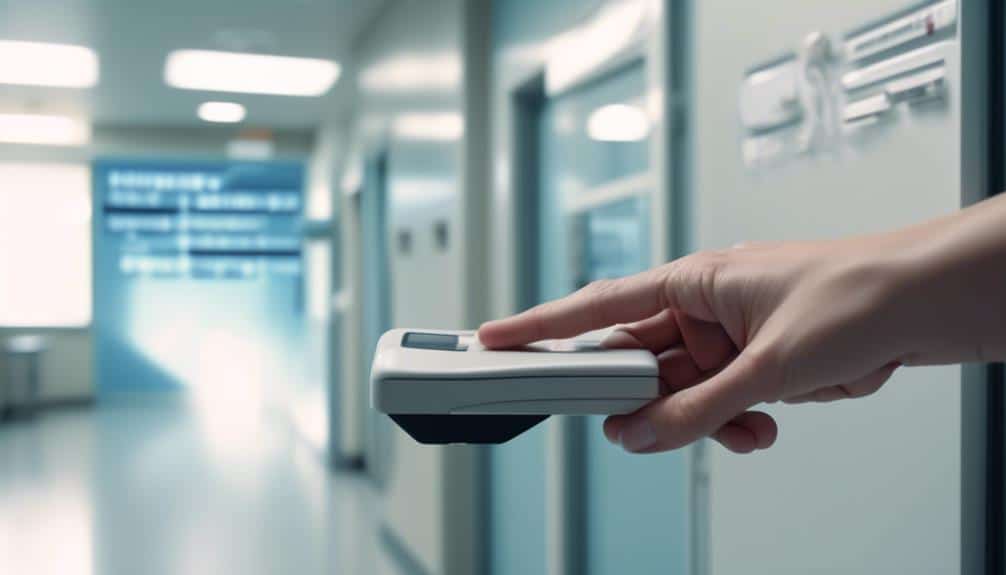
We can enhance security in healthcare facilities with the use of keycard access systems. Keycard technology provides a secure and convenient way to control access to different areas within a healthcare facility. These systems utilize a keycard, which is a plastic card embedded with a magnetic stripe or a proximity chip, to grant or deny access to authorized personnel.
Keycard access systems offer several advantages over traditional lock and key systems. Firstly, they provide an added layer of security by requiring a specific keycard to gain entry. This helps to prevent unauthorized individuals from accessing sensitive areas such as patient rooms, medication storage areas, or restricted zones. Additionally, keycard access systems allow for easy management of access privileges. Authorized personnel can be assigned specific access levels, ensuring that they can only enter areas relevant to their role.
Furthermore, keycard security systems provide a detailed audit trail of access activity. This allows administrators to monitor and track who accessed a specific area and at what time. In the event of a security breach or incident, this information can be invaluable in identifying the responsible party and taking appropriate action.
High-Security Deadbolts
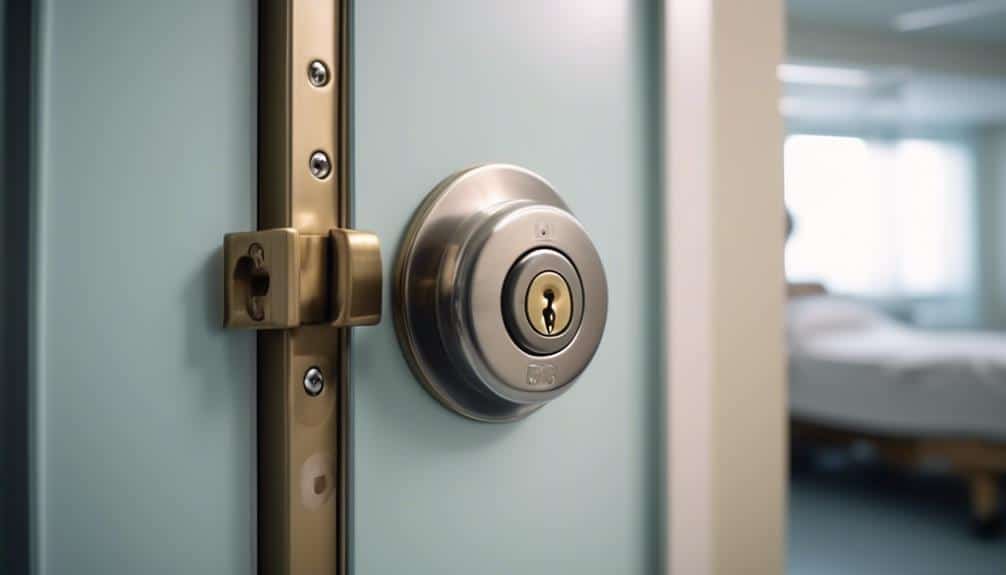
High-security deadbolts are an essential component of healthcare facility security. These locks offer advanced features and benefits such as pick-resistant cylinders and reinforced strike plates, providing an extra layer of protection against unauthorized entry.
Installation and maintenance of high-security deadbolts are relatively straightforward, and they can be easily integrated with existing access control systems for seamless operation.
Lock Features and Benefits
When considering the security of healthcare facilities, it's essential to explore the various features and benefits offered by high-security deadbolts. These locks are designed to provide maximum protection against unauthorized access and ensure the safety of patients, staff, and valuable assets.
Here are four key features and benefits of high-security deadbolts:
- Lock Durability: High-security deadbolts are built to withstand the wear and tear of constant use. They're made from robust materials that can withstand forceful entry attempts, ensuring long-lasting performance.
- Lock Resistance: These deadbolts offer superior resistance to picking, drilling, and other common lock bypass techniques. Their advanced mechanisms and complex keyways make them extremely difficult to compromise, providing an extra layer of security.
- Key Control: High-security deadbolts often come with restricted keyways, which means duplicate keys can only be made with proper authorization. This prevents unauthorized key duplication and enhances overall security.
- Enhanced Security Features: Many high-security deadbolts incorporate additional security features such as anti-tampering mechanisms, reinforced strike plates, and hardened steel bolts. These features further strengthen the lock's resistance to forced entry.
Installation and Maintenance
To ensure proper installation and maintenance of high-security deadbolts, it is crucial to follow the manufacturer's guidelines and recommendations. Here are some important installation techniques and maintenance strategies to consider:
| Installation Techniques | Maintenance Strategies |
|---|---|
| Carefully measure and mark the door for accurate placement of the deadbolt | Regularly inspect the deadbolt for any signs of wear or damage |
| Use a template to ensure precise drilling of the necessary holes | Lubricate the deadbolt mechanism with a high-quality graphite lubricant |
| Install the deadbolt securely, ensuring all screws are tightened properly | Test the deadbolt periodically to ensure smooth operation and proper alignment |
Following these installation techniques and maintenance strategies will help maximize the effectiveness and longevity of high-security deadbolts in healthcare facilities. It is also important to train staff on proper usage and provide regular updates on security protocols to maintain a secure environment.
Compatibility With Access Control
Using access control systems in conjunction with high-security deadbolts can enhance the overall security of healthcare facilities. When considering lock compatibility and access control integration, there are a few key factors to keep in mind:
- Compatibility: Ensure that the high-security deadbolt you choose is compatible with your existing access control system. This will help streamline the installation process and ensure smooth operation.
- Integration: Look for high-security deadbolts that can seamlessly integrate with your access control system. This allows for centralized control and monitoring of all locks within the facility, increasing efficiency and security.
- Multi-factor authentication: Consider high-security deadbolts that support multi-factor authentication methods such as keycards, PIN codes, or biometric credentials. This adds an extra layer of security and prevents unauthorized access.
- Remote control: Opt for high-security deadbolts that offer remote control capabilities. This allows authorized personnel to lock or unlock doors remotely, providing convenience and flexibility while maintaining security.
Access Control Systems
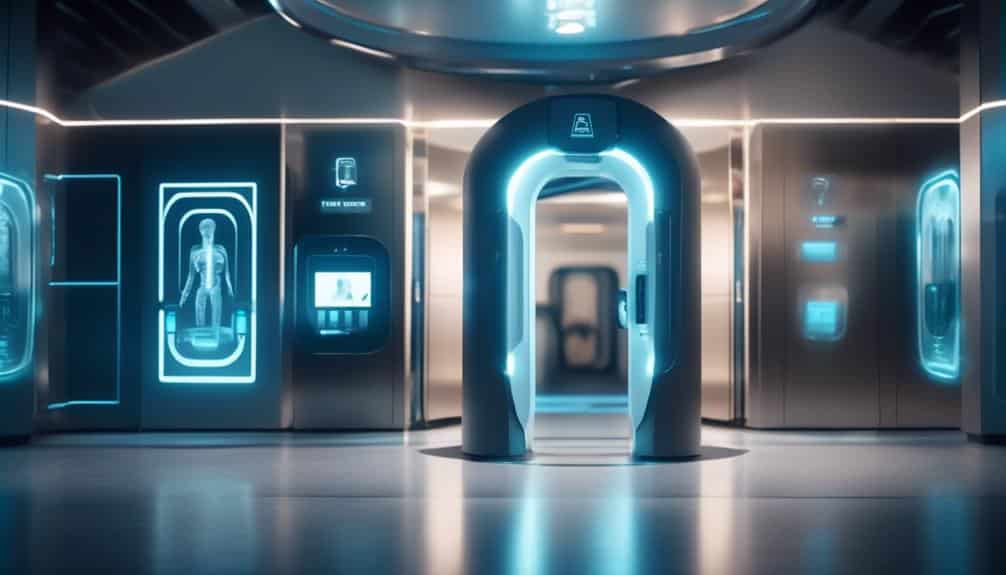
Access control systems play a crucial role in maintaining the security and integrity of healthcare facilities. These systems provide authorized personnel with secure and convenient access to different areas within the facility, while also preventing unauthorized entry.
One common type of access control system used in healthcare facilities is electronic keypads. These keypads require users to enter a unique code or PIN to gain access. They're easy to use and can be programmed to allow access to specific areas based on individual needs and clearance levels. Electronic keypads can also be integrated with other security systems, such as surveillance cameras, for enhanced monitoring and control.
Another popular access control method is the use of proximity cards. These cards contain embedded microchips that transmit data to a card reader when held in close proximity. This allows authorized personnel to gain entry by simply presenting their card to the reader. Proximity cards offer a higher level of security compared to traditional keys, as they can be easily deactivated if lost or stolen.
Smart Locks
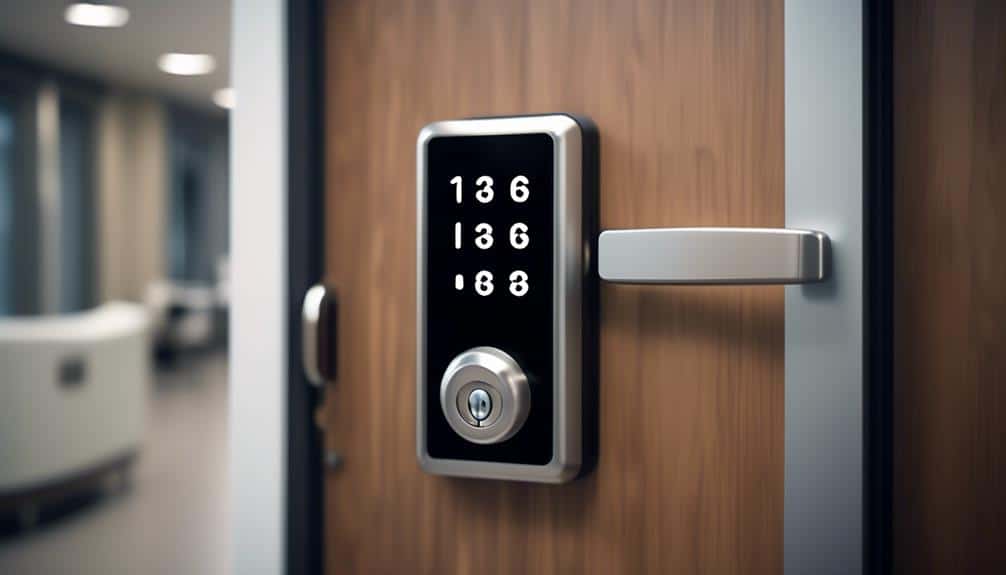
Smart locks are an advanced and secure solution for controlling access to healthcare facilities. With their innovative features and technology, they offer several benefits and simplify the installation process. Here are four reasons why smart locks are a great choice for healthcare facilities:
- Enhanced Security:
Smart locks provide a higher level of security compared to traditional locks. They use advanced encryption and authentication protocols to protect against unauthorized access. Additionally, they can be integrated with other security systems, such as video surveillance and alarm systems, to create a comprehensive security solution.
- Convenience:
Smart locks eliminate the need for physical keys, which can be lost or stolen. Instead, authorized personnel can use key cards, PIN codes, or biometric authentication to gain access. This not only enhances convenience but also allows for easy management of access rights for different individuals or departments.
- Remote Access Control:
With smart locks, administrators can remotely manage access permissions. They can grant or revoke access to specific areas in real-time, from anywhere using a computer or mobile device. This feature is especially useful in emergency situations or when immediate access changes are required.
- Easy Installation:
Installing smart locks is relatively straightforward. They can often be retrofitted onto existing doors without major modifications. Additionally, many smart lock systems offer wireless connectivity, eliminating the need for complex wiring.
Frequently Asked Questions
How Do Electronic Locks Differ From Traditional Locks in Terms of Security for Healthcare Facilities?
Electronic locks differ from traditional locks in terms of security for healthcare facilities due to their ability to address electronic lock vulnerabilities and overcome traditional lock limitations.
Electronic locks utilize advanced technology, such as encryption and access control systems, to provide enhanced security measures. They're resistant to picking and tampering, offer audit trails for tracking access, and can be easily reprogrammed.
These features make electronic locks a more secure option for healthcare facilities, ensuring the protection of sensitive patient information and valuable assets.
Are Biometric Locks More Secure Than Keycard Access Systems for Healthcare Facilities?
Biometric locks vs keycard access systems: Which is more reliable?
Well, when it comes to healthcare facilities, the effectiveness of keycard access systems can't be underestimated. They provide a high level of security and can be easily managed.
However, biometric locks offer an even higher level of security as they rely on unique biological traits like fingerprints or iris scans. These locks are harder to bypass or duplicate, making them a top choice for healthcare facilities that prioritize security.
What Are the Benefits of Using High-Security Deadbolts in Healthcare Facilities?
Using high-security deadbolts in healthcare facilities offers numerous benefits. These locks provide an added layer of protection, ensuring the safety of patients, staff, and sensitive information.
With their advanced technology and robust construction, high-security deadbolts are resistant to tampering and forced entry. They also offer key control, allowing administrators to monitor and restrict access to specific areas.
This level of security is crucial in healthcare facilities, where patient privacy and the safeguarding of valuable assets are of utmost importance.
Can Access Control Systems Be Integrated With Existing Security Systems in Healthcare Facilities?
Yes, access control systems can be integrated with existing security systems in healthcare facilities. By integrating these systems, healthcare facilities can enhance their security protocols and ensure a comprehensive approach to safeguarding sensitive areas.
The compatibility of access control systems with different security protocols allows for seamless integration, providing a centralized and efficient solution. This integration not only improves security but also streamlines access management, minimizing the risk of unauthorized entry and ensuring the safety of patients, staff, and valuable assets.
How Do Smart Locks Provide an Added Layer of Security for Healthcare Facilities Compared to Other Lock Types?
Smart locks offer an added layer of security for healthcare facilities compared to traditional lock types. With the advancements in smart lock technology, healthcare facilities can benefit from features like keyless entry, remote access control, and real-time activity monitoring.
These electronic locks provide advantages such as improved access control, audit trails, and the ability to easily revoke access privileges. This enhances the overall security of the facility and helps ensure the safety of patients, staff, and sensitive information.

